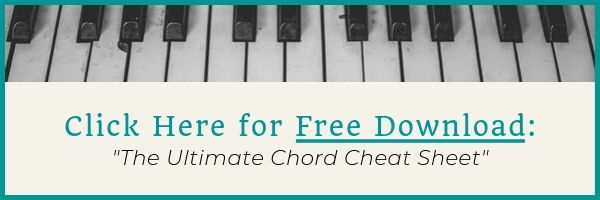G7 Piano Chord: Notes & How To Play It
The G7 piano chord is often one of the first 7th chords that people learn to play. It's really an important one to learn and understand as it comes up a lot. Especially if you're playing in the key of C, which many beginners are.
Here, you'll learn:
- G7 piano chord notes
- how to play G7 chord in terms of fingering or finger positions
- video on how to play G7
- how G7 should sound
- the G7sus4 chord
- chord progressions using G7
- and some theory to top things off
G7 Piano Chord Notes
The G7 chord is a type of seventh chord. It's a four note chord as well. This might be your first 4 note chord and in that case, you might feel a bit of a stretch in your hand (but don't worry, that's normal in the beginning).
The notes of the G7 chord are: G B D F.
You can see the G7 chord on the treble clef and on the piano keys below.
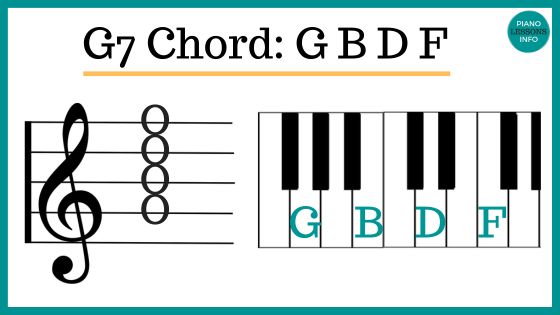
One of the big questions that comes up when it comes to chords is which hand do you play what in. And this is especially true when it comes to a chord like G7.
While there is no right or wrong way to play chords in each hand, here are a few things to consider.
G7 Piano Chord Right Hand Options
Here are some of the ways you could play the G7 chord in your right hand:
- play the full chord in the right hand
- play parts of the chord, especially that 7th note (F)
- play the melody of the song you're playing in the right hand with some notes of the G7 chord (maybe underneath the melody)
- or just play the melody and leave the entire chord for your left hand
G7 Piano Chord Left Hand Options
Here are some of the ways you could play the G7 chord in your left hand:
- play the full chord, solid (all notes together)
- play the full chord, broken (one note at a time)
- creating a bass line, maybe moving up the chord and back down again ( notes: G B D F D B)
- Just play the note G and let the right hand play the chord
G7 Piano Chord Sounds & How to Play It Video
Seventh chords definitely have a distinct sound. Some people love it and others actually don't like it much at all. Because G and F are close together, it can create an almost clashing sound - but not quite.
The video below will show you how to play the G7 chord, including which fingers to use, and also how it'll sound.
G7 Chord Piano Finger Positions
As G7 is a 4 note chord, it can feel a bit uncomfortable to play - at least in the beginning. It is good to get into the habit of playing this chord with the correct fingering to start with. That will set in place good muscle memory.
The G7 chord piano finger positions are as follows:
Right hand: use finger 1, 2, 4, 5, which is everything but your middle finger, when in root position.
Left hand: use finger 1, 2, 4, 5, which is everything but your middle finger, when in root position.
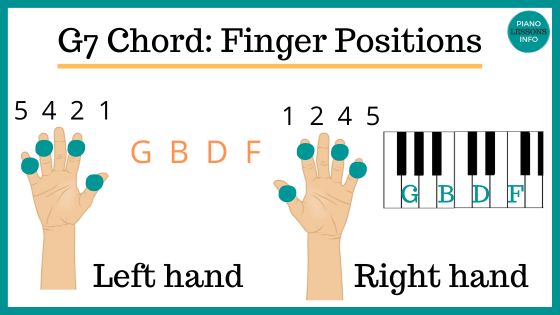
Once you get comfortable with the chord and start playing it after other chords, you might find you use different finger positions to play it and that's fine. But when setting up your foundation, I'd recommend sticking to this fingering.
G7sus4 Piano Chord
One variation of the G7 chord is the suspended seventh chord which can be written any of these ways:
- G7sus
- Gsus7
- G7sus4
The notes of the G7sus4 chord are: G C D F
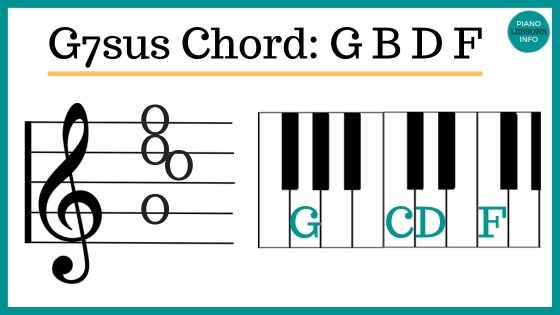
This is essentially a G4 / Gsus chord (G C D) with the 7th (F) added on top.
If you're wondering why I keep referring the F as the 7th note, take a look at the theory section below which will explain in.
G7 Chord Progression
Now that you understand this chord, it's great to practice it! Here are some chord progressions to help.
G7 Chord Progression 1:
C F G7 C
G7 Chord Progression 2:
C A D G7
G7 Chord Progression 3:
Dm7 G7 C CM7
(Dm7 = D F A C)
(CM7 = C E G B)
Here are a few more chord progressions.
How Do You Make A G7 Chord (Chord Theory)
Seventh chords are really useful to understand as they come up so often. The great thing is once you have the chord formula and the key signature or scale, you can figure out any 7th chord.
There are a few steps to figuring out 7th chords or the G7 chord in this case.
Step 1: The Chord Formula
We want to know what the chord formula is for the G7 chord and we get this from the chord title. In the case of G7, it's the 7 that gives us the formula.
The formula for a 7th chord is the 1st, 3rd, 5th, and lowered 7th notes of the major scale.
Formula: 1, 3, 5, b7
For the G7 chord, we want to know the 1st, 3rd, 5th and lowered 7th notes of the G major scale.
What does "lowered 7th" mean? It means we're taking the note down one semi-tone. So moving down to the left by one note. A sharp becomes a natural ("normal" white note). And a white note becomes a flat.
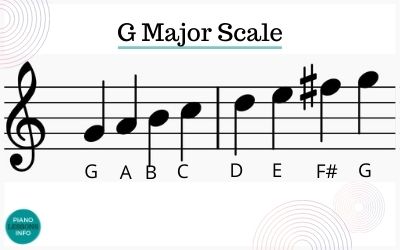
Step 2: Apply the Major Scale / Key Signature to the Chord Forumla
When we take the formula and apply it to the G major scale we have:
1 = G
3 = B
5 = D
b7 = F
The key of G has a sharp - F# - so when we lower it, go down one semi-tone, it becomes F.
If you need more help understanding key signatures, visit the key signatures page. And if you're like to learn more about 7th chords, click here.
If you need to look up more chords, visit the Piano Chord Charts page or download your own copy below.
Free Download:
Ultimate Chord Cheat Sheet

Subscribe below and get free access to the (printable) Ultimate Chord Cheat Sheet.
Recent Articles
-
Piano Notes Chart
Nov 20, 23 10:21 PM
Find a piano notes chart for treble clef and bass clef notes as well as the different types of notes. -
D Chord on Piano + Diagram, How To & Theory
Oct 24, 23 12:20 AM
Learn how to play the D chord on piano with diagram, fingering, D/A, D/F# and a theory explainer. -
Diminished Piano Chords: Chart & How to Make Them
Oct 09, 23 09:23 PM
Learn the different diminished piano chords and how to make them. Here you'll find both a diminished chord chart and an explanation.
- Home
- 14 Day Chord Challenge
- G7 Piano Chord
Free Download:
Ultimate Chord Cheat Sheet

Subscribe below and get free access to the (printable) Ultimate Chord Cheat Sheet.




